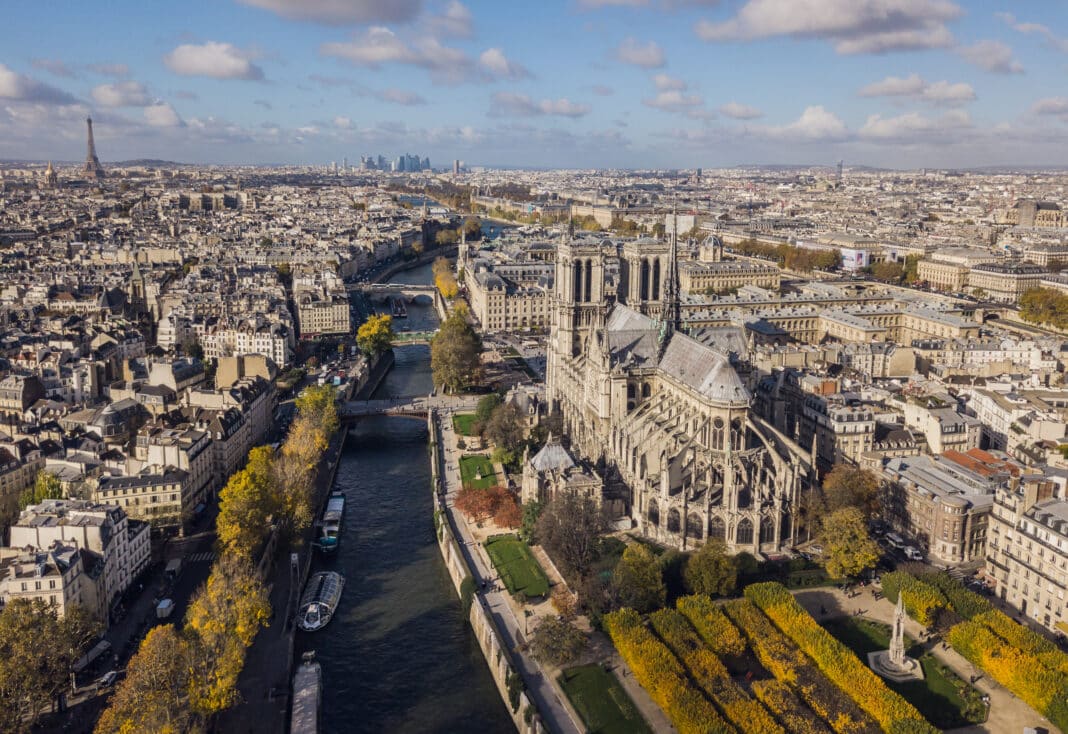More than 500 construction crews are working around the clock to restore the Norte-Dame de Paris Cathedral in time for the 2024 Paris Olympics Opening Ceremony just over five years after the fire.
Following the tragic passing of Jean-Louis Georgelin in August, Philippe Jost, the project’s new superintendent, has confirmed that the pace of construction has not slowed, with the 100m wooden spire “visible from the end of this year” and “gradually emerging from scaffolding.”
The plan is to have the cathedral involved in the Games Opening Ceremony, which will take place on the waters of the River Seine, flowing through the city centre and around the Ile-de-la-Cite, the island site of Notre-Dame.
As reported in July, a crane installed six giant wooden triangles weighing seven tonnes on the cathedral roof, which sits above the wooden spire, as part of a complicated installation that took two months to finalise.
The pieces were successfully fit into place “like a giant jigsaw puzzle” and now sit above the solid oak timber frame and the wooden spire.
Now, attention is turning to the nave and choir timber frame, historically known as la forêt or the forest.
Once a dense web of old-growth timber – where 13th-century builders harvested 5000 oak trees from 522 hectares of an ancient forest – to support the roof with its 200 tonnes of lead cladding and the cathedral’s oak-and-lead central spire.
Wood Cental understands that construction crews began installing the massive framework, 32 metres long, nearly 14 metres wide and 10 metres high, for the choir in May, with the installation of the timber framework over the vaults beginning late last month.
Made up of 35 trusses and 22 half-trusses, forming six bays and a semi-circular apse, carpenters combine 800-year-old construction techniques and 3D modelling to speed up the reconstruction.
Computers draw detailed plans for carpenters to help ensure their hand-chiselled beams fit together perfectly.
“Traditional carpenters had a lot of that in their head,” according to Peter Henrikson, one of the US carpenters involved in the project.
“[It’s] pretty amazing to think about how they did this with what they had, the tools and technology they had at the time.”
According to the Friends of Notre Dame De Paris, carpenters must follow strict guidelines in handling the raw material – which, according to the late Jean-Louis Georgelin, is crucial in “restoring this cathedral as it was built in the Middle Ages.”
“It is a way to be faithful to the [handiwork] of all the people who built all the extraordinary monuments in France.”
The guidelines include
“After selecting and harvesting oak trees, the logs were transported to two workshops in Normandy and Anjou. Carpenters work on this raw material through the following stages:
- They begin with rough shaping, utilising a mixed technique involving mechanical sawing of two sides of the logs, followed by manual squaring – the art of transforming an entire tree into a beam using an axe.
- Carpenters then proceed with hand-finishing each wood piece using a “doloire,” an ancient cutting instrument used to thin or regularise the thickness of a wood piece.
- Concurrently, they create the full-scale layout, known as “épure,” on the ground. UNESCO inscribes this “timber layout” art on the list of intangible cultural heritage of humanity. This step is crucial as it determines the placement of each piece within the overall structure and positions the joinery of the pieces.
- Next, they perform the “alignment.” This step involves horizontally assembling around twenty pieces for each truss above the épure layout to verify the perfect fit of their roughly fifty joinery connections, all crafted without metal pieces. During the alignment of the layout, the wood pieces are compared to the model to trace their future connections and to verify their fit as they are shaped. Each truss is unique, so the carpenters engrave a code on the beams to identify the location and orientation of each piece in the final structure.
- Finally, the carpenters carry out a test assembly of a batch of six trusses (two main trusses and four secondary ones), interconnected by purlins, to form a complete bay. This dry-fit assembly takes place in the workshop to ensure that the cuts are accurate and that the interlocking of the pieces is compatible. This anticipates any adjustments that might arise during the final assembly.
- Once all the wood is cut, the timber frame is transported piece by piece to the cathedral, assembled into trusses or rafters and then raised to their final positions.”
Acoustics have evolved as the cathedral is a living building
However, it is not just the cathedral’s structure involved in the US $1 Billion plus restoration, with acoustic engineers looking to restore Notre-Dame’s “unique acoustics.”
Last week, US-based NPR interviewed the acoustic engineers involved in restoration who are now “mapping out the cathedral’s acoustics, calculating how sound reverberates against each interior feature of the building.”
They are using a recorded concert, known as the “Ghost Orchestra Project”, filmed inside the cathedral in 2013 and a computer model to determine how acoustics vary between sections of the cathedral.
“We are painting audio frescos,” acoustic engineer Brian Katz said, “and are using a medieval castle from the same period and the same tools to recapture the original sounds of Notre Dame’s construction.”
He said the sound inside the cathedral has evolved as construction materials have changed.
“In the Middle Ages, before there was all this seating, the floor would have probably been covered with straw or hay to absorb, you know, water and mud from people.”
“Then there was the transformation from a religious to a mass tourist site. Carpeting was added in the 1990s to reduce footfall,” he said.
- For more information about the Notre Dame restoration, visit Wood Central’s special feature on constructing the wooden spire and the installation of the trusses over the cathedral roof.






